Abstract
The effects of chronic diethylstilbestrol treatment on rat prolactin mRNA was analyzed by in situ hybridization histochemistry. Forty-day-old female rats were treated with 10 mg diethylstilbestrol in Silastic tubes for 3, 6, and 9 weeks. Estrogen treatment for 9 weeks increased pituitary wet weight (51.6 +/- 2.4 versus 7.9 +/- 0.31 mg for controls), serum prolactin (4155 +/- 571 versus 47.1 +/- 8.9 ng/ml for controls), and the percentage of immunoreactive prolactin cells (69% +/- 3% versus 34% +/- 2% for controls). In situ hybridization studies showed an increase in rat prolactin mRNA with increasing duration of estrogen treatment. After 9 weeks of estrogen treatment, there was a 2.3-fold increase in rat prolactin mRNA. 3H-cDNA was distributed diffusely throughout the anterior pituitary in both normal and hyperplastic pituitaries. There were no separate foci of adenomatous pituitary with increased labeling or with increased immunoreactive PRL cells. Although transplantable pituitary MtT/W15 tumors secreted very large amounts of PRL, compared with pituitaries from DES-treated rats, rat prolactin mRNA as evaluated by mean grain counts was considerably less in the MtT/W15 tumor than in DES-treated pituitary cells. These results show that in situ hybridization histochemistry can be used to detect changes in rat prolactin mRNA in tissue sections from the anterior pituitary with chronic estrogen treatment and that these pituitaries show a diffuse increase in immunoreactive prolactin cells and cellular prolactin mRNA, rather than distinct adenomatous areas within the glands.
Full text
PDF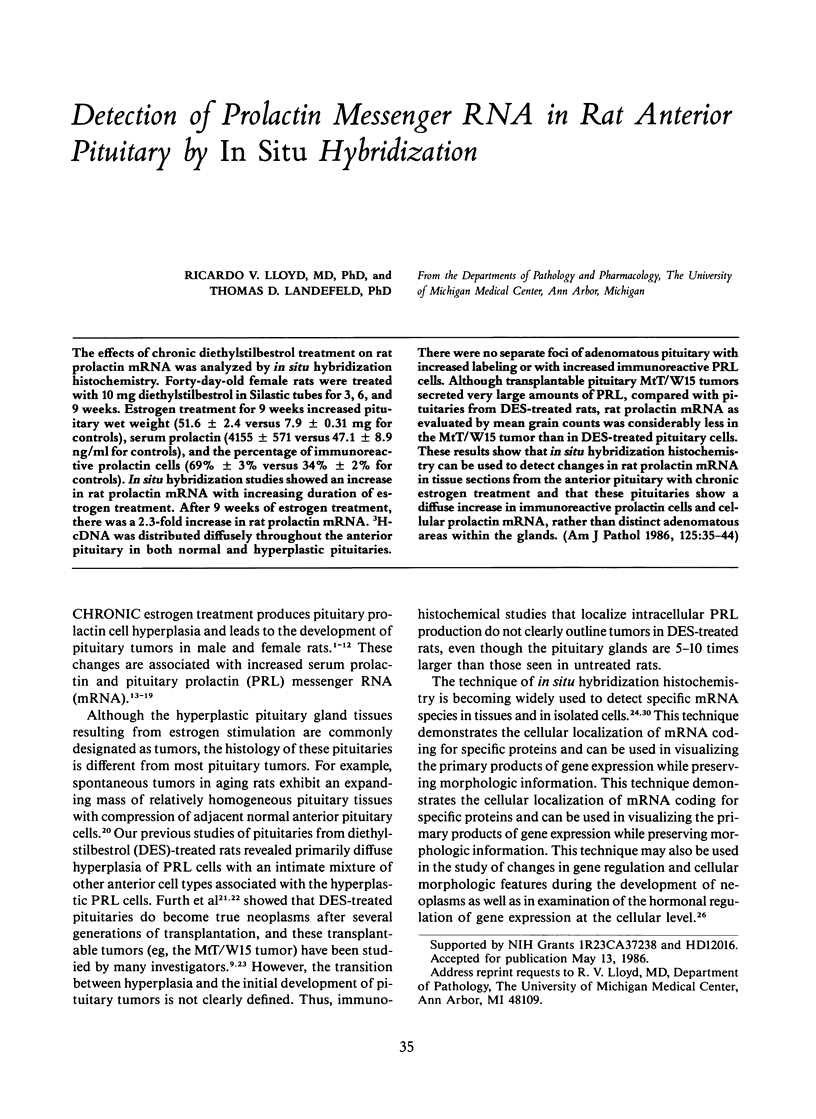
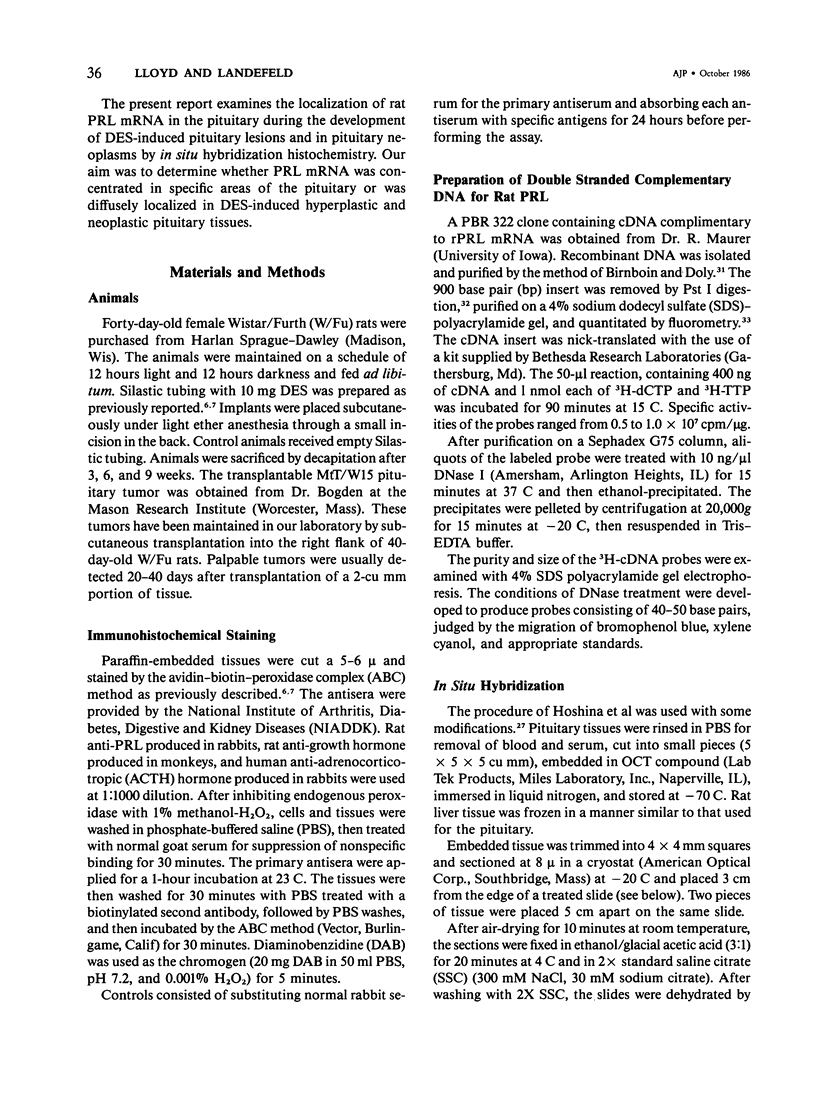
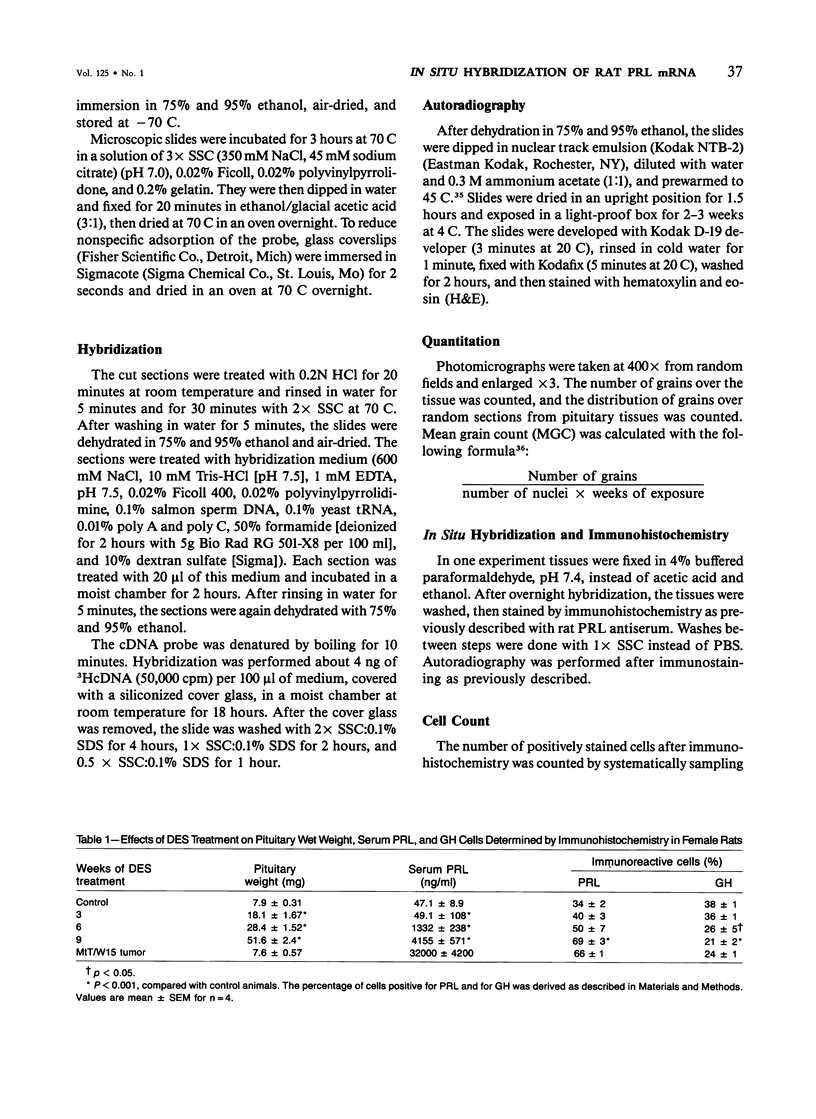
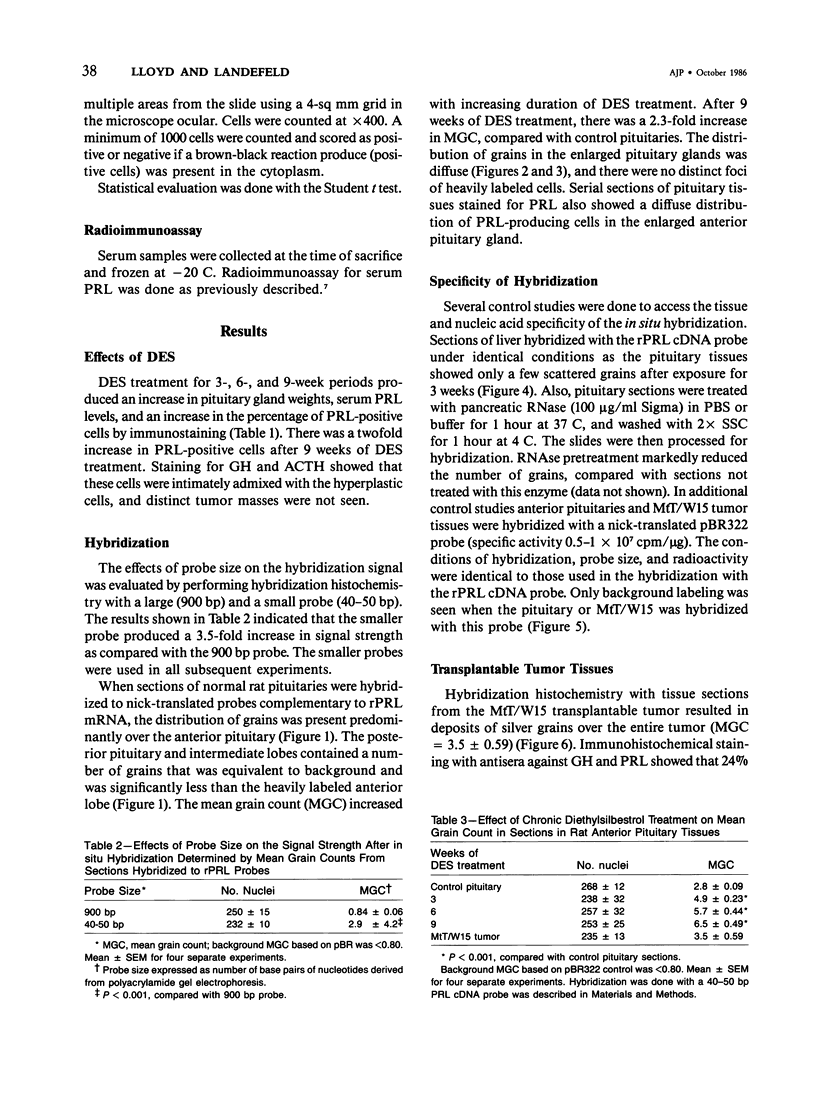

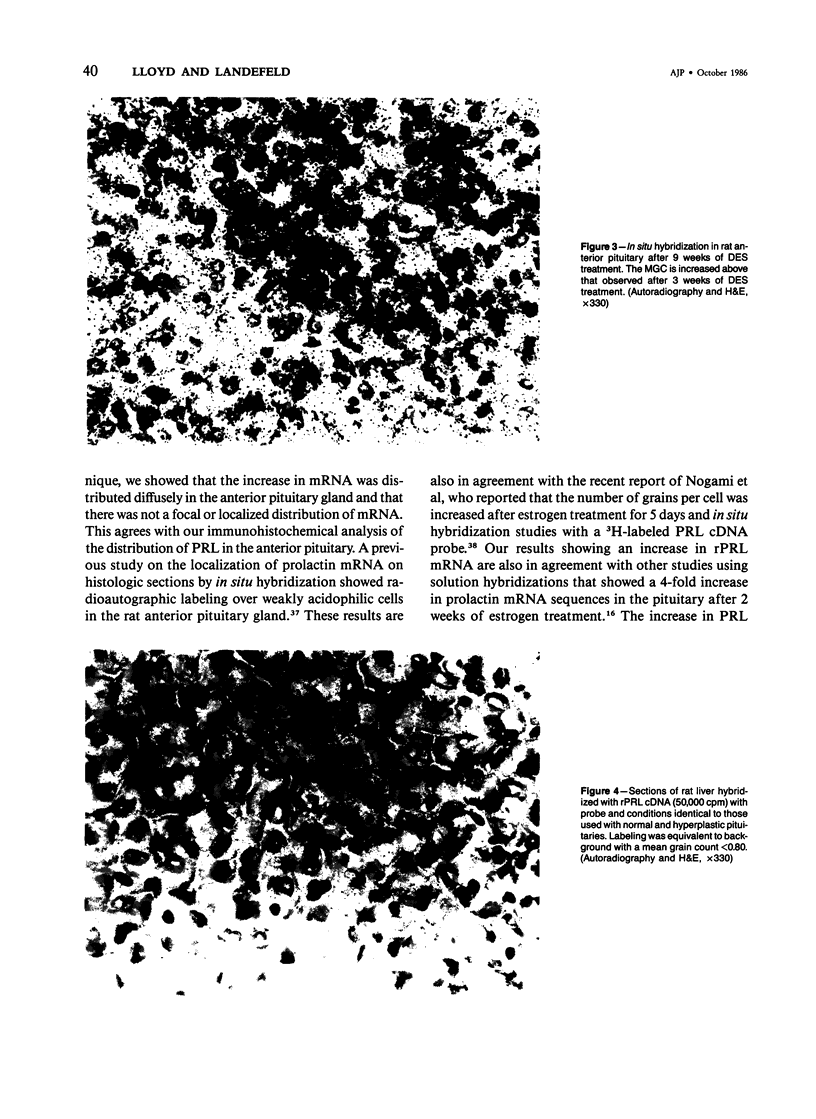
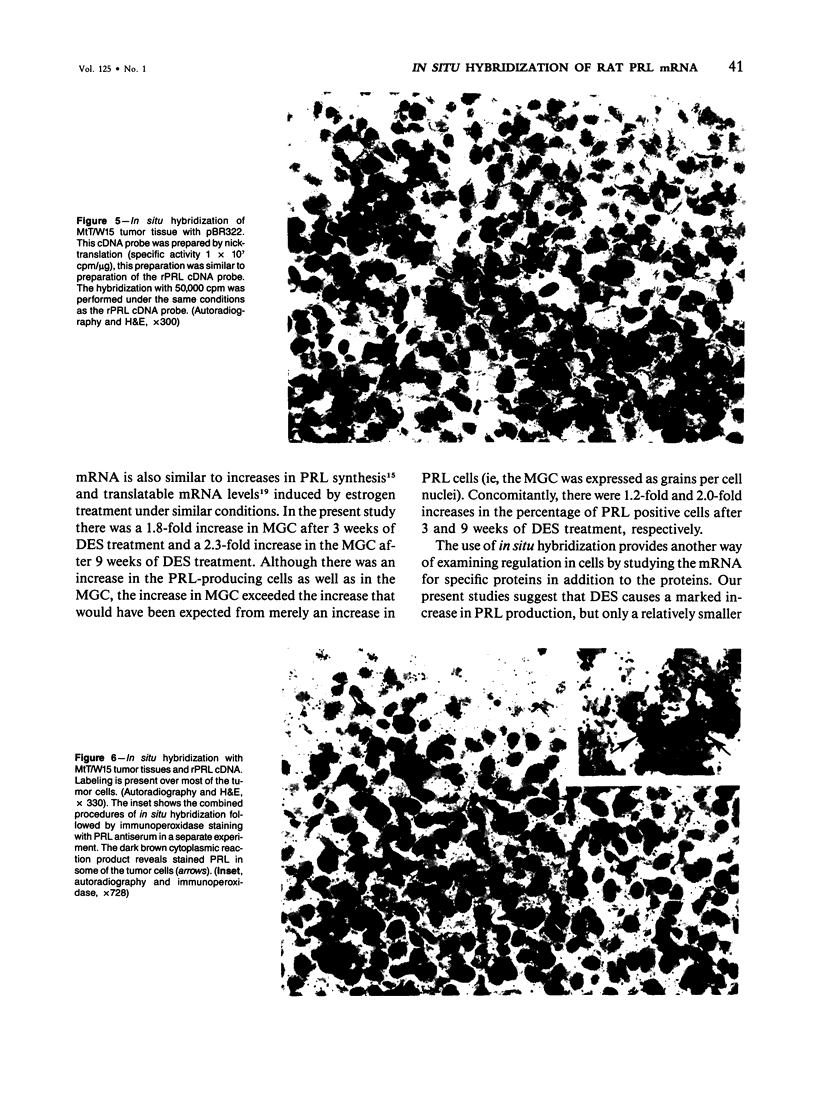
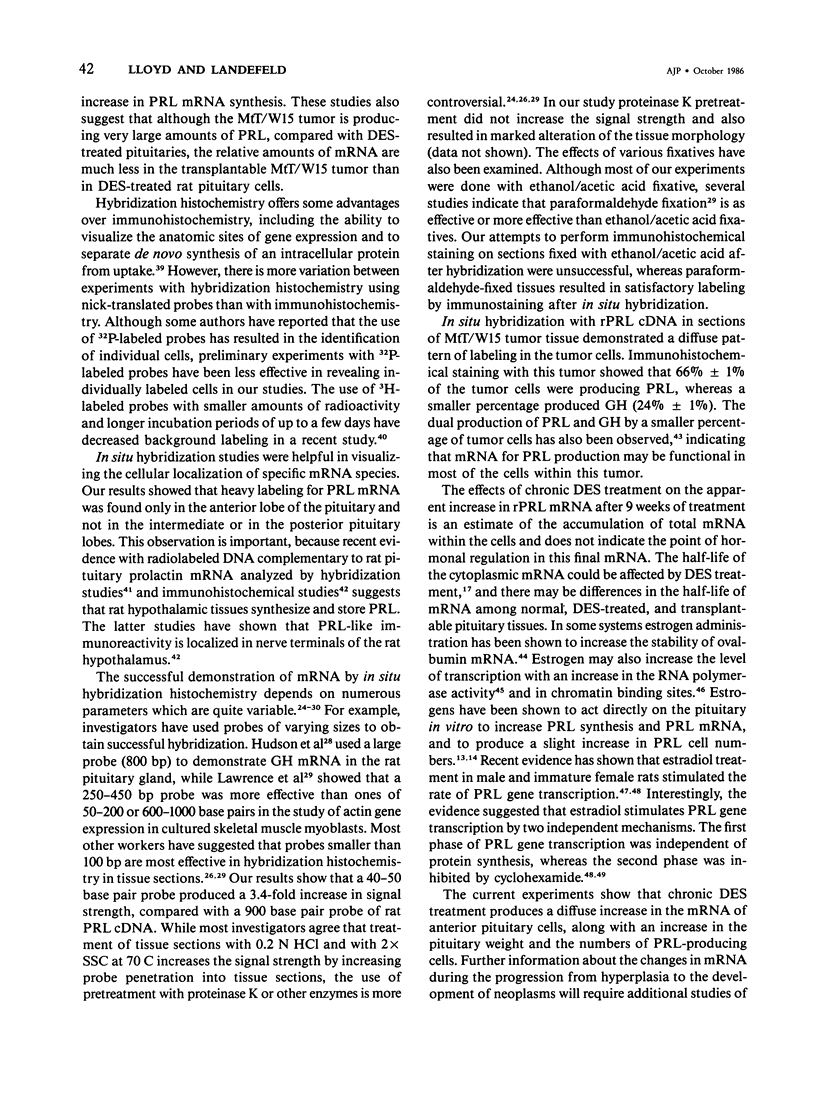
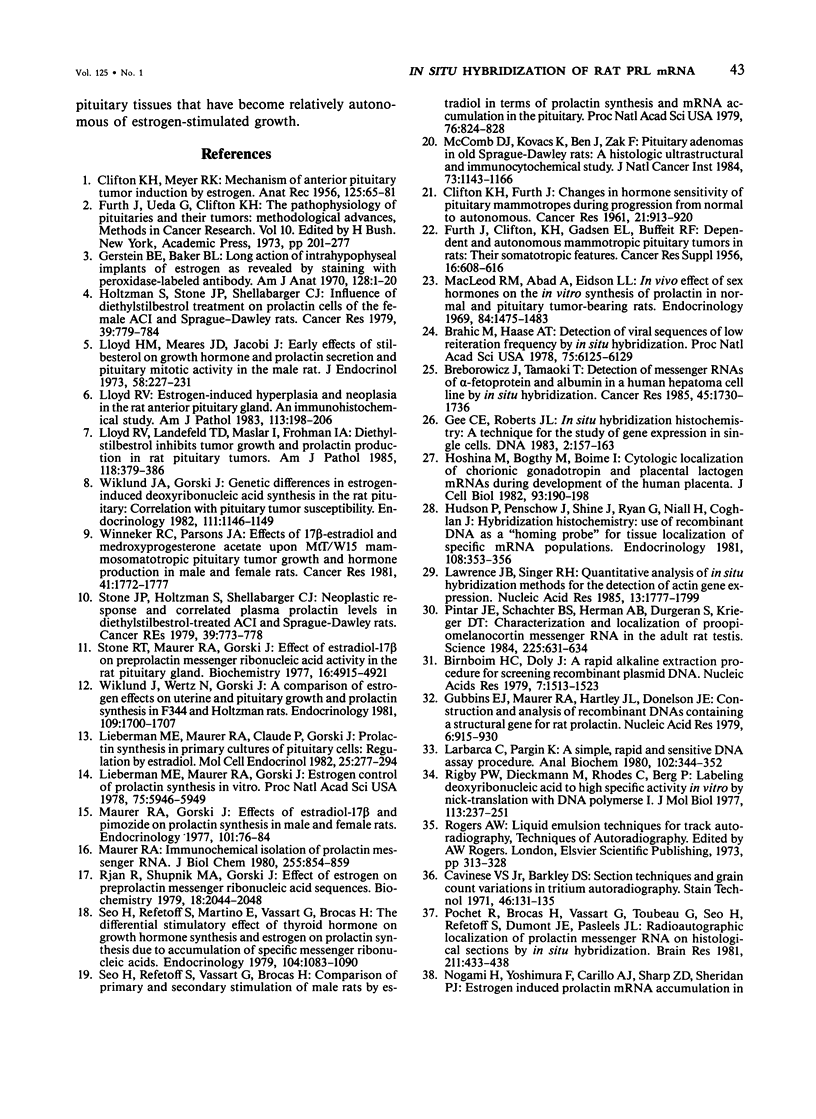
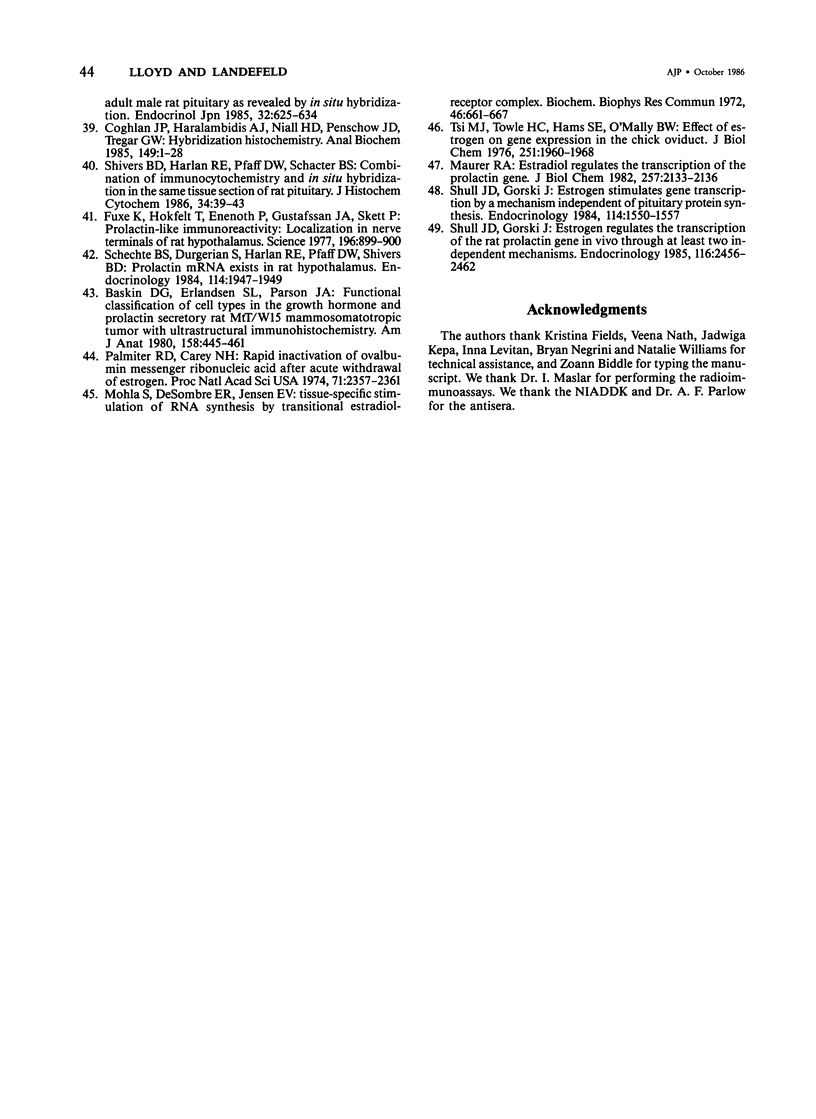
Images in this article
Selected References
These references are in PubMed. This may not be the complete list of references from this article.
- BUFFETT R. F., CLIFTON K. H., FURTH J., GADSDEN E. L. Dependent and autonomous mammotropic pituitary tumors in rats; their somatotropic features. Cancer Res. 1956 Aug;16(7):608–616. [PubMed] [Google Scholar]
- Baskin D. G., Erlandsen S. L., Parsons J. A. Functional classification of cell types in the growth hormone- and prolactin-secreting rat MtTW mammosomatotropic tumor with ultrastructural immunocytochemistry. Am J Anat. 1980 Aug;158(4):455–461. doi: 10.1002/aja.1001580407. [DOI] [PubMed] [Google Scholar]
- Birnboim H. C., Doly J. A rapid alkaline extraction procedure for screening recombinant plasmid DNA. Nucleic Acids Res. 1979 Nov 24;7(6):1513–1523. doi: 10.1093/nar/7.6.1513. [DOI] [PMC free article] [PubMed] [Google Scholar]
- Brahic M., Haase A. T. Detection of viral sequences of low reiteration frequency by in situ hybridization. Proc Natl Acad Sci U S A. 1978 Dec;75(12):6125–6129. doi: 10.1073/pnas.75.12.6125. [DOI] [PMC free article] [PubMed] [Google Scholar]
- Breborowicz J., Tamaoki T. Detection of messenger RNAs of alpha-fetoprotein and albumin in a human hepatoma cell line by in situ hybridization. Cancer Res. 1985 Apr;45(4):1730–1736. [PubMed] [Google Scholar]
- CLIFTON K. H., FURTH J. Changes in hormone sensitivity of pituitary mammotropes during progression from normal to autonomous. Cancer Res. 1961 Aug;21:913–920. [PubMed] [Google Scholar]
- CLIFTON K. H., MEYER R. K. Mechanism of anterior pituitary tumor induction by estrogen. Anat Rec. 1956 May;125(1):65–81. doi: 10.1002/ar.1091250106. [DOI] [PubMed] [Google Scholar]
- Caviness V. S., Jr, Barkley D. S. Section thickness and grain count variation in tritium autoradiography. Stain Technol. 1971 May;46(3):131–135. doi: 10.3109/10520297109067837. [DOI] [PubMed] [Google Scholar]
- Coghlan J. P., Aldred P., Haralambidis J., Niall H. D., Penschow J. D., Tregear G. W. Hybridization histochemistry. Anal Biochem. 1985 Aug 15;149(1):1–28. doi: 10.1016/0003-2697(85)90472-5. [DOI] [PubMed] [Google Scholar]
- Fuxe K., Hökfelt T., Eneroth P., Gustafsson J. A., Skett P. Prolactin-like immunoreactivity: localization in nerve terminals of rat hypothalamus. Science. 1977 May 20;196(4292):899–900. doi: 10.1126/science.323973. [DOI] [PubMed] [Google Scholar]
- Gee C. E., Roberts J. L. In situ hybridization histochemistry: a technique for the study of gene expression in single cells. DNA. 1983;2(2):157–163. doi: 10.1089/dna.1983.2.157. [DOI] [PubMed] [Google Scholar]
- Gersten B. E., Baker B. L. Local action of intrahypophyseal implants of estrogen as revealed by staining with peroxidase-labeled antibody. Am J Anat. 1970 May;128(1):1–19. doi: 10.1002/aja.1001280102. [DOI] [PubMed] [Google Scholar]
- Gubbins E. J., Maurer R. A., Hartley J. L., Donelson J. E. Construction and analysis of recombinant DNAs containing a structural gene for rat prolactin. Nucleic Acids Res. 1979 Mar;6(3):915–930. doi: 10.1093/nar/6.3.915. [DOI] [PMC free article] [PubMed] [Google Scholar]
- Holtzman S., Stone J. P., Shellabarger C. J. Influence of diethylstilbestrol treatment on prolactin cells of female ACI and Sprague-Dawley rats. Cancer Res. 1979 Mar;39(3):779–784. [PubMed] [Google Scholar]
- Hoshina M., Boothby M., Boime I. Cytological localization of chorionic gonadotropin alpha and placental lactogen mRNAs during development of the human placenta. J Cell Biol. 1982 Apr;93(1):190–198. doi: 10.1083/jcb.93.1.190. [DOI] [PMC free article] [PubMed] [Google Scholar]
- Hudson P., Penschow J., Shine J., Ryan G., Niall H., Coghlan J. Hybridization histochemistry: use of recombinant DNA as a "homing probe" for tissue localization of specific mRNA populations. Endocrinology. 1981 Jan;108(1):353–356. doi: 10.1210/endo-108-1-353. [DOI] [PubMed] [Google Scholar]
- Labarca C., Paigen K. A simple, rapid, and sensitive DNA assay procedure. Anal Biochem. 1980 Mar 1;102(2):344–352. doi: 10.1016/0003-2697(80)90165-7. [DOI] [PubMed] [Google Scholar]
- Lawrence J. B., Singer R. H. Quantitative analysis of in situ hybridization methods for the detection of actin gene expression. Nucleic Acids Res. 1985 Mar 11;13(5):1777–1799. doi: 10.1093/nar/13.5.1777. [DOI] [PMC free article] [PubMed] [Google Scholar]
- Lieberman M. E., Maurer R. A., Claude P., Gorski J. Prolactin synthesis in primary cultures of pituitary cells: regulation by estradiol. Mol Cell Endocrinol. 1982 Mar;25(3):277–294. doi: 10.1016/0303-7207(82)90084-3. [DOI] [PubMed] [Google Scholar]
- Lieberman M. E., Maurer R. A., Gorski J. Estrogen control of prolactin synthesis in vitro. Proc Natl Acad Sci U S A. 1978 Dec;75(12):5946–5949. doi: 10.1073/pnas.75.12.5946. [DOI] [PMC free article] [PubMed] [Google Scholar]
- Lloyd H. M., Meares J. D., Jacobi J. Early effects of stilboestrol on growth hormone and prolactin secretion and on pituitary mitotic activity in the male rat. J Endocrinol. 1973 Aug;58(2):227–231. doi: 10.1677/joe.0.0580227. [DOI] [PubMed] [Google Scholar]
- Lloyd R. V. Estrogen-induced hyperplasia and neoplasia in the rat anterior pituitary gland. An immunohistochemical study. Am J Pathol. 1983 Nov;113(2):198–206. [PMC free article] [PubMed] [Google Scholar]
- Lloyd R. V., Landefeld T. D., Maslar I., Frohman L. A. Diethylstilbestrol inhibits tumor growth and prolactin production in rat pituitary tumors. Am J Pathol. 1985 Mar;118(3):379–386. [PMC free article] [PubMed] [Google Scholar]
- MacLeod R. M., Abad A., Eidson L. H. In vivo effect of sex hormones on the in vitro synthesis of prolactin and growth hormone in normal and pituitary tumor-bearing rats. Endocrinology. 1969 Jun;84(6):1475–1483. doi: 10.1210/endo-84-6-1475. [DOI] [PubMed] [Google Scholar]
- Maurer R. A. Estradiol regulates the transcription of the prolactin gene. J Biol Chem. 1982 Mar 10;257(5):2133–2136. [PubMed] [Google Scholar]
- Maurer R. A., Gorski J. Effects of estradiol-17beta and pimozide on prolactin synthesis in male and female rats. Endocrinology. 1977 Jul;101(1):76–84. doi: 10.1210/endo-101-1-76. [DOI] [PubMed] [Google Scholar]
- Maurer R. A. Immunochemical isolation of prolactin messenger RNA. J Biol Chem. 1980 Feb 10;255(3):854–859. [PubMed] [Google Scholar]
- McComb D. J., Kovacs K., Beri J., Zak F. Pituitary adenomas in old Sprague-Dawley rats: a histologic, ultrastructural, and immunocytochemical study. J Natl Cancer Inst. 1984 Nov;73(5):1143–1166. [PubMed] [Google Scholar]
- Mohla S., DeSombre E. R., Jensen E. V. Tissue-specific stimulation of RNA synthesis by transformed estradiol-receptor complex. Biochem Biophys Res Commun. 1972 Jan 31;46(2):661–667. doi: 10.1016/s0006-291x(72)80191-8. [DOI] [PubMed] [Google Scholar]
- Nogami H., Yoshimura F., Carrillo A. J., Sharp Z. D., Sheridan P. J. Estrogen induced prolactin mRNA accumulation in adult male rat pituitary as revealed by in situ hybridization. Endocrinol Jpn. 1985 Oct;32(5):625–634. doi: 10.1507/endocrj1954.32.625. [DOI] [PubMed] [Google Scholar]
- Palmiter R. D., Carey N. H. Rapid inactivation of ovalbumin messenger ribonucleic acid after acute withdrawal of estrogen. Proc Natl Acad Sci U S A. 1974 Jun;71(6):2357–2361. doi: 10.1073/pnas.71.6.2357. [DOI] [PMC free article] [PubMed] [Google Scholar]
- Pintar J. E., Schachter B. S., Herman A. B., Durgerian S., Krieger D. T. Characterization and localization of proopiomelanocortin messenger RNA in the adult rat testis. Science. 1984 Aug 10;225(4662):632–634. doi: 10.1126/science.6740329. [DOI] [PubMed] [Google Scholar]
- Pochet R., Brocas H., Vassart G., Toubeau G., Seo H., Refetoff S., Dumont J. E., Pasteels J. L. Radioautographic localization of prolactin messenger RNA on histological sections by in situ hybridization. Brain Res. 1981 May 4;211(2):433–438. doi: 10.1016/0006-8993(81)90969-0. [DOI] [PubMed] [Google Scholar]
- Rigby P. W., Dieckmann M., Rhodes C., Berg P. Labeling deoxyribonucleic acid to high specific activity in vitro by nick translation with DNA polymerase I. J Mol Biol. 1977 Jun 15;113(1):237–251. doi: 10.1016/0022-2836(77)90052-3. [DOI] [PubMed] [Google Scholar]
- Ryan R., Shupnik M. A., Gorski J. Effect of estrogen on preprolactin messenger ribonucleic acid sequences. Biochemistry. 1979 May 15;18(10):2044–2048. doi: 10.1021/bi00577a031. [DOI] [PubMed] [Google Scholar]
- Schachter B. S., Durgerian S., Harlan R. E., Pfaff D. W., Shivers B. D. Prolactin mRNA exists in rat hypothalamus. Endocrinology. 1984 May;114(5):1947–1949. doi: 10.1210/endo-114-5-1947. [DOI] [PubMed] [Google Scholar]
- Seo H., Refetoff S., Martino E., Vassart G., Brocas H. The differential stimulatory effect of thyroid hormone on growth hormone synthesis and estrogen on prolactin synthesis due to accumulation of specific messenger ribonucleic acids. Endocrinology. 1979 Apr;104(4):1083–1090. doi: 10.1210/endo-104-4-1083. [DOI] [PubMed] [Google Scholar]
- Seo H., Refetoff S., Vassart G., Brocas H. Comparison of primary and secondary stimulation of male rats by estradiol in terms of prolactin synthesis and mRNA accumulation in the pituitary. Proc Natl Acad Sci U S A. 1979 Feb;76(2):824–828. doi: 10.1073/pnas.76.2.824. [DOI] [PMC free article] [PubMed] [Google Scholar]
- Shivers B. D., Harlan R. E., Pfaff D. W., Schachter B. S. Combination of immunocytochemistry and in situ hybridization in the same tissue section of rat pituitary. J Histochem Cytochem. 1986 Jan;34(1):39–43. doi: 10.1177/34.1.3510246. [DOI] [PubMed] [Google Scholar]
- Shull J. D., Gorski J. Estrogen regulates the transcription of the rat prolactin gene in vivo through at least two independent mechanisms. Endocrinology. 1985 Jun;116(6):2456–2462. doi: 10.1210/endo-116-6-2456. [DOI] [PubMed] [Google Scholar]
- Shull J. D., Gorski J. Estrogen stimulates prolactin gene transcription by a mechanism independent of pituitary protein synthesis. Endocrinology. 1984 May;114(5):1550–1557. doi: 10.1210/endo-114-5-1550. [DOI] [PubMed] [Google Scholar]
- Stone J. P., Holtzman S., Shellabarger C. J. Neoplastic responses and correlated plasma prolactin levels in diethylstilbestrol-treated ACI and Sprague-Dawley rats. Cancer Res. 1979 Mar;39(3):773–778. [PubMed] [Google Scholar]
- Stone R. T., Maurer R. A., Gorski J. Effect of estradiol-17 beta on preprolactin messenger ribonucleic acid activity in the rat pituitary gland. Biochemistry. 1977 Nov 1;16(22):4915–4921. doi: 10.1021/bi00641a027. [DOI] [PubMed] [Google Scholar]
- Tsai M. J., Towle T. C., Harris S. E., O'Malley B. W. Effect of estrogen on gene expression in the chick oviduct. J Biol Chem. 1976 Apr 10;251(7):1960–1968. [PubMed] [Google Scholar]
- Wiklund J. A., Gorski J. Genetic differences in estrogen-induced deoxyribonucleic acid synthesis in the rat pituitary: correlations with pituitary tumor susceptibility. Endocrinology. 1982 Oct;111(4):1140–1149. doi: 10.1210/endo-111-4-1140. [DOI] [PubMed] [Google Scholar]
- Wiklund J., Wertz N., Gorski J. A comparison of estrogen effects on uterine and pituitary growth and prolactin synthesis in F344 and Holtzman rats. Endocrinology. 1981 Nov;109(5):1700–1707. doi: 10.1210/endo-109-5-1700. [DOI] [PubMed] [Google Scholar]
- Winneker R. C., Parsons J. A. Effects of 17 beta-estradiol and medroxyprogesterone acetate upon MtTW15 mammosomatotropic pituitary tumor growth and hormone production in male and female rats. Cancer Res. 1981 May;41(5):1772–1777. [PubMed] [Google Scholar]








